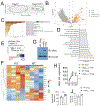Inhibitory co-receptor Lag3 supports Foxp3+ regulatory T cell function by restraining Myc-dependent metabolic programming
- PMID: 39236718
- PMCID: PMC12309520
- DOI: 10.1016/j.immuni.2024.08.008
Inhibitory co-receptor Lag3 supports Foxp3+ regulatory T cell function by restraining Myc-dependent metabolic programming
Abstract
Lymphocyte activation gene 3 (Lag3) is an inhibitory co-receptor expressed on activated T cells and has been proposed to regulate regulatory T (Treg) cell function. However, its precise modality and mechanisms remain elusive. We generated Treg cell-specific Lag3-mutant mouse models and found that Lag3 was essential for Treg cell control of autoimmunity. RNA sequencing analysis revealed that Lag3 mutation altered genes associated with metabolic processes, especially Myc target genes. Myc expression in Lag3-mutant Treg cells was increased to the level seen in conventional T helper (Th)1-type effector cells and directly correlated with their metabolic profiles and in vivo suppressive functions. The phosphatidylinositol 3-kinase (PI3K)-Akt-Rictor pathway was activated in Lag3-mutant Treg cells, and inhibiting PI3K, Rictor, or lactate dehydrogenase A (Ldha), a key Myc target enzyme converting pyruvate to lactate, was sufficient to restore normal metabolism and suppressive function in Lag3-mutant Treg cells. These findings indicate that Lag3 supports Treg cell suppression partly by tuning Myc-dependent metabolic programming.
Keywords: Lag3; Myc; Treg cells; autoimmunity; metabolism.
Copyright © 2024 Elsevier Inc. All rights reserved.
Conflict of interest statement
Declaration of interests J.C. is a founder and shareholder in Moonlight Bio.
Figures







References
-
- Lohning M, Hutloff A, Kallinich T, Mages HW, Bonhagen K, Radbruch A, Hamelmann E, and Kroczek RA (2003). Expression of ICOS in vivo defines CD4+ effector T cells with high inflammatory potential and a strong bias for secretion of interleukin 10. J Exp Med 197, 181–193. 10.1084/jem.20020632. - DOI - PMC - PubMed
Publication types
MeSH terms
Substances
Grants and funding
LinkOut - more resources
Full Text Sources
Molecular Biology Databases
Miscellaneous

